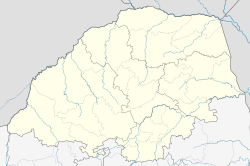Nancefield
|
Musina Messina |
|
|---|---|
|
|
|
| Coordinates: 22°20′17″S 30°02′30″E / 22.33806°S 30.04167°ECoordinates: 22°20′17″S 30°02′30″E / 22.33806°S 30.04167°E | |
| Country | South Africa |
| Province | Limpopo |
| District | Vhembe |
| Municipality | Musina |
| Established | 1968 |
| Area | |
| • Total | 109.38 km2 (42.23 sq mi) |
| Population (2011) | |
| • Total | 42,678 |
| • Density | 390/km2 (1,000/sq mi) |
| Racial makeup (2011) | |
| • Black African | 93.3% |
| • Coloured | 0.4% |
| • Indian/Asian | 0.7% |
| • White | 5.1% |
| • Other | 0.5% |
| First languages (2011) | |
| • Venda | 48.8% |
| • Sotho | 11.7% |
| • Northern Sotho | 10.4% |
| • English | 5.4% |
| • Other | 23.7% |
| Postal code (street) | 0900 |
| PO box | 0900 |
| Area code | 015 |
| Website | http://www.musina.gov.za |
Musina or Messina (see name situation below) is the northernmost town in the Limpopo province of South Africa. It is located near the confluence of the Limpopo River with the Sand River and the border to Zimbabwe. It has a population of between 20,000 and 40,000. Iron ore, coal, magnetite, graphite, asbestos, diamonds, semi-precious stones and copper are mined in the region.
The Musina tribe discovered copper and settled here. In the 20th century European prospectors rediscovered the large copper deposits and established the town of Messina. The spelling of the name was changed to Musina in 2003 to correct the colonial-era misspelling of the name of the Musina people.
The Limpopo River is a dry river bank which flows annually in rains when lichen and other plant species of the desert region come alive. Sometimes, it floods. The low-shrub and thorny tree lands that surround Musina and thrive in rains are alive with animals in sanctuaries that offer experienced-only camping safari accessible by sand and rock road tracks. Access is generally good, with the N1 road from Johannesburg through Musina northwards being wide tar, as are most other roads in the area.
The link with Zimbabwe at Beitbridge has become one of the busiest roads in the world and the busiest in Africa, due to black market importers from Zimbabwe and people looking for employment. This is mainly due to thousands crossing the border into South Africa every day. According to the New York Times, in January 2009 Musina had a shifting population of about 15,000 foreigners, overwhelmingly Zimbabweans, many of whom lived in a refugee camp at the showground or in the streets. [1]
...
Wikipedia



